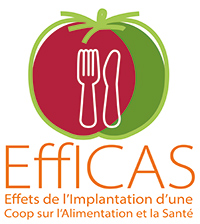EffICAS: Evaluating the effects of establishing a food co-op
In Quebec, a number of actions are planned to improve the food environment, based on policies and action plans. For example, measure 13.1 of the Government Action Plan to Foster Economic Inclusion and Social Participation 2017–2023 aims to improve access to healthy, nutritious, and affordable food for low-income people. In addition, measure 3.1 of the Politique gouvernementale de prévention en santé (PGPS) 2015–2025 aims to promote geographic and economic access to healthy food, particularly in deprived or geographically isolated communities.
Why care about food co-ops?
Healthy eating is an important determinant of health. Food choices are influenced by the individual characteristics and the context in which people live. The physical, sociocultural, economic, and political characteristics of a given living environment may or may not encourage people to adopt a healthy diet.1–4
Food co-ops are a promising solution for providing geographic access to foods of high nutritional value for communities with poor access to these foods,5–7 which could improve the diet and health of residents.
The cooperative model also enables the community to rally around a common project, which can contribute to the community’s sense of belonging and vitality.8–9
The EffICAS study focuses on small rural communities because they have few stores offering foods of high nutritional value. In fact, in some regions of Quebec far from major urban centres, between 8% and 23% of the population live in food deserts.10 Moreover, some rural areas have a higher proportion of overweight adults and also a higher proportion of adults who don't eat enough fruit and vegetables than the Quebec average.11–12
Logic model of the EffICAS study
The figure below shows the expected effects of setting up a food co-op in a rural and geographically isolated community that is considered a food desert.
Based on the scientific literature, the research team hypothesizes that establishing a co-op in the community improves citizens’diet quality, the vitality and well-being of the community, and reduces marginal income-related household food insecurity.
Figure 1 - Expected effects of establishing a food co-op in a rural and geographically isolated community that is considered a food desert
Evaluation process
The EffICAS study is looking at food co-ops to see whether the hypotheses about their effects actually become reality. Studying the process of establishing a food co-op provides information to better understand the effects that actually occur. Evaluating the effects of improving geographic access to foods of high nutritional value has a positive impact on the perception of access to these foods, diet quality, household food insecurity, and individual health, as well as on community well-being and vitality.
The co-op projects being examined by the EffICAS study involve establishing a new co-op or relocating and upgrading an existing one. These projects are the responsibility of provisional committees and citizen boards, not the research team.
Food co-op projects are autonomous and follow their own timetable. The evaluation thus concerns events over which the research team has no control. Different times of establishment in the various communities helps compare a community that has opened its food co-op (intervention group) with communities that have not yet opened theirs (control group).
Three main data collection stages are used to track each co-op under study:
- before the establishment of the co-op;
- six months after opening;
- one year after opening.
Several tools were used to gather information:
- Questionnaires to collect data on individual and collective characteristics before and after the opening of the co-ops.
- A database showing the location of food stores in Quebec to measure the distance between the nearest grocery store (or co-op) and the respondents’ homes.
- An interview guide to appreciate the process of mobilizing and implementing a food co-op.
References
- Giskes, K., van Lenthe, F., Avendano-Pabon, M., & Brug, J. (2011). A systematic review of environmental factors and obesogenic dietary intakes among adults: Are we getting closer to understanding obesogenic environments? Obesity Reviews: An Official Journal of the International Association for the Study of Obesity, 12(5), e95‑e106.
- Raine, K. D. (2005). Determinants of healthy eating in Canada: An overview and synthesis. Canadian Journal of Public Health = Revue canadienne de santé publique, 96 Suppl 3, S8-14, S8-15.
- Story, M., Kaphingst, K. M., Robinson-O’Brien, R., & Glanz, K. (2008). Creating healthy food and eating environments: Policy and environmental approaches. Annual Review of Public Health, 29, 253 272.
- WHO. (2002). Diet, nutrition and the prevention of chronic diseases: Report of a joint WHO/FAO expert consultation, Geneva, 28 January - 1 February 2002.
- Cadieux, É., Corbeil, D., & Payette, J. (2017). Accessibilité géographique aux commerces d’alimentation. Outil pour comprendre et utiliser la cartographie des unités résidentielles répondant aux critères de désert alimentaire.
- Lebel, A. (2015). L’Identification des déserts alimentaires en milieu rural.
- Table intersectorielle régionale en saines habitudes de vie COSMOSS du Bas-Saint-Laurent (TIR-SHV). (2018). Favoriser la saine alimentation grâce aux outils d’aménagement du territoire.
- Conseil québécois de la coopération et de la mutualité. (s. d.). Coût d’opportunité du maintien des services marchands de proximité. Consulté 15 février 2023.
- Conseil québécois de la coopération et de la mutualité. (2014). Guide d’information – Une économie de proximité à votre portée.
- Robitaille, É. (2018, novembre 6). Présentation : Accessibilité géographique aux commerces alimentaires au Québec : Analyse de situation (mise à jour).
- Infocentre. (s. d.-a). Fiche 5.1 : Répartition de la population de 18 ans et plus selon le statut pondéral (EQSP).
- Infocentre. (s. d.-b). Fiche 59 : Proportion de la population consommant moins de 5 fois par jour des fruits et des légumes (ESCC).



